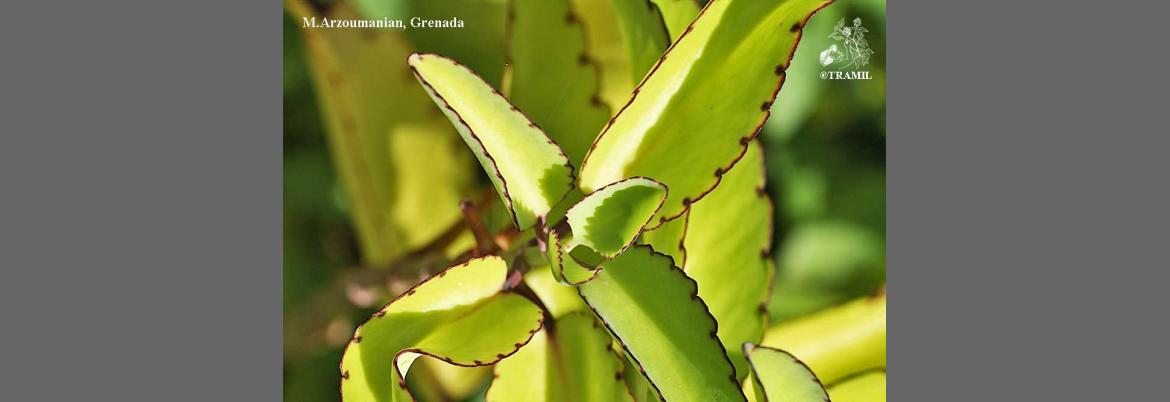1 WENIGER B, 1987-88
Encuesta TRAMIL. enda-caribe, Santo Domingo, Rep. Dominicana.
2 GIRÓN L, 1988
Encuesta TRAMIL (Costa atlántica). Centro Mesoamericano de Tecnología CEMAT, Guatemala, Guatemala.
3 LONGUEFOSSE JL, NOSSIN E, 1990-95
Enquête TRAMIL. Association pour la valorisation des plantes médicinales de la Caraïbe AVPMC, Fort de France, Martinique.
4 LAGOS-WITTE S, 1988-89, 1996
Encuesta TRAMIL. Laboratorio de Histología Vegetal y Etnobotánica, Departamento de Biología, Universidad Nacional Autónoma de Honduras UNAH, Tegucigalpa, Honduras.
5 OCAMPO R, 1988
Encuesta TRAMIL (Costa atlántica), Instituto de Desarrollo Agrario, Universidad de Costa Rica, San José, Costa Rica.
6 PINZON M, 1994
Encuesta TRAMIL (Isla de San Andrés). Laboratorio de Fitofarmacología, Departamento de Farmacología, Facultad de Salud, Universidad del Valle, Cali, Colombia.
7 WENIGER B, ROUZIER M, 1986
Enquête TRAMIL. Service Oecuménique d'Entraide SOE, Port au Prince, Haïti.
8 WENIGER B, SAVARY H, DAGUIHL R, 1984
Tri phytochimique de plantes de la liste TRAMIL. Laboratoire de chimie des substances naturelles, Faculté de Médecine et de Pharmacie, Université d'Etat d'Haïti, Port au Prince, Haïti.
9 GAIND KN, GUPTA RL, 1971
Flavonoid glycosides from Kalanchoe pinnata. Planta Med 20(4):368-373.
10 GAIND KN, GUPTA RL, 1973
Phenolic components from the leaves of Kalanchoe pinnata. Planta Med 23(12):149-153.
11 YAMAGISHI T, YAN X, WU R, MC PHAIL D, MC PHAIL A, LEE K, 1988
Structure and stereochemistry of bryophyllin-A, a novel potent cytotoxic bufadienolide orthoacetate from Bryophyllum pinnatum. Chem Pharm Bull 36(4):1615-1617.
12 YAN,XZ: LEE,KS: YAMAGISHI,T, 1992
Isolation and identification of cytotoxic components from Bryophyllum pinnatum. Shanghai Yike Daxue Xuebao 19(3):206-208.
13 AKIHISA T, KOKKE W, TAMURA T, MATSUMOTO T, 1991
Sterols of Kalanchoe pinnata: first report of the isolation of both C-24 epimers of 24-alkyl-delta-25-sterols from a higher plant. Lipids 26(8):660-665.
14 GAIND KN, GUPTA RL, 1972
Alkanes, alkanols, triterpenes and sterols from Kalanchoe pinnata. Phytochemistry 11(4):1500-1502.
15 SIDDIQUI S, FAIZI S, SIDDIQUI B, SULTANA N, 1989
Triterpenoids and phenanthrenes from leaves of Bryophyllum pinnatum. Phytochemistry 28(9):2433-2438.
16 BULEN WA, VARNER JE, BURRELL RC, 1952
Separation of organic acids from plant tissues. Anal Chem 24:187-190.
17 PAL S, SEN T, CHAUDHURI AK, 1999
Neuropsychopharmacological profile of the methanolic fraction of Bryophyllum pinnatum leaf extract. J Pharm Pharmacol 51(3):313-318.
18 MORAES V, COSTA S, BERGMANN R, 1992
Immunomodulatory activity of Brazilian medicinal plants. Dept. of Biochemistry, ICB, URFJ, Rio de Janeiro, Brasil.
19 OBASEIKI-EBOR EE, 1985
Preliminary report on the in vitro antibacterial activity of Bryophyllum pinnatum leaf juice. Afr J Med Sci 14(3-4):199-202.
20 SINGH K, PATHAK R, 1984
Effect of leaves extracts of some higher plants on spore germination of Ustilago maydes and U. nuda. Fitoterapia 55(5):318-320.
21 NAOVI S, KHAN M, VOHORA S, 1991
Antibacterial, antifungal and anthelmintic investigation on Indian medicinal plants. Fitoterapia 62(3):21-228.
22 HEMA D, TIDJANI M, BASSENE E, POUSSET JL, GIONO-BARBER H, 1986
African medicinal plants. XXIV. Study of the antiinflammatory activity of Bryophyllum pinnatum. Plant Med Phytother 20(3):231-235.
23 FENG P, HAYNES L, MAGNUS K, PLIMMER J, SHERRAT H, 1962
Pharmacological screening of some West Indian medicinal plants. J Pharm Pharmacol 14:556-561.
24 ANDRONOVA L, 1972
Antitussive properties of certain medical plants. Rast Resur 8:588-591.
25 BERSHTEJN E, 1972
Utilisation du jus de Kalanchoe pinnata dans le traitement des ulcères trophiques de la jambe. Vest Khir URSS 108(3):116-118.
26SVANIDZE N, LANOVENKLY V, SÁNCHEZ A, RODRÍGUEZ P, 1975
Kalanchoe pinnata como planta medicinal en Cuba. Rev Cub Farm 9(3):225-228.
27 YAMAGISHI T, HARUNA M, YAN XZ, CHANG JJ, LEE KH, 1989
Antitumor agents. 110. Bryophylline B., a novel potent cytotoxic bufadienolide from Bryophyllum pinnatum. J Nat Prod 52(5):1071-1079.
28 BOAKYE-YIADOM K, 1977
Antimicrobial properties of some West African medicinal plants. 1. Antimicrobial action of Bryophyllum pinnatum. Quart J Crude Res 15:201-202.
29 PERRY LM, METZGER J, 1980
Medicinal plants of East and Southeast Asia: attributed properties and uses. Cambridge, USA: MIT Press.
30 DUKE JA, 1992
Handbook of biologically active phytochemicals and their bioactivities. Boca Raton, USA: CRC Press.
31 DUKE JA, 1992
Handbook of phytochemical constituents of GRAS Herbs and other economic plants. Boca Raton, USA: CRC Press.
32 OLIVER B, 1960
Medicinal plants in Nigeria. Ibadan, Nigeria: Nigerian College of Arts, Science and Technology.
33 PAZOS L, COTO T, GONZÁLEZ S, 2003
Toxicidad oral, aguda en ratones, de la hoja de Kalanchoe pinnata. Informe TRAMIL. Laboratorio de Ensayos Biológicos, Universidad de Costa Rica, San Pedro, Costa Rica.
34 PAZOS L, COTO T, GONZÁLEZ S, 2003
Toxicidad oral, aguda en ratones, del extracto acuoso del zumo de la hoja de Kalanchoe pinnata. Informe TRAMIL. Laboratorio de Ensayos Biológicos, Universidad de Costa Rica, San Pedro, Costa Rica.
35 PAZOS L, COTO T, GONZÁLEZ S, 2003
Estudio de irritabilidad dérmica, en piel lesionada de conejo, de hoja fresca machacada de Kalanchoe pinnata. Informe TRAMIL.Laboratorio de Ensayos Biológicos, Universidad de Costa Rica, San Pedro, Costa Rica.
36 YOKEL R, OGZEWALLA CD, 1981
Effects of plant ingestion in rats determined by the conditioned taste aversion procedure. Toxicon 19(2):223-232.
37 BHAKUNI O, DHAR ML, DHAR MM, DHAWAN BN, MEHROTRA BN, 1969
Screening of Indian plants for biological activity. Part II. Indian J Exp Biol 7:250-262.
38 PAL S, SEN T, CHAUDHURI AKN,1999
Neuropsychopharmacological profile of the methanolic fraction of Bryophyllum pinnatum leaf extract. J Pharm Pharmacol 51(3):313-318.
39 REPPAS GP, 1995
Bryophyllum pinnatum poisoning of cattle. Aust Vet J 72(11):425-427.
40 MCKENZIE RA, FRANKE FP, DUNSTER PJ, 1987
The toxicity to cattle and bufadienolide content of six Bryophyllum species. Aust Vet J 64(10):298-301.






















